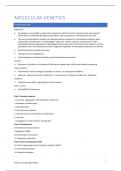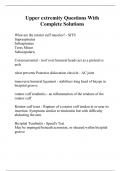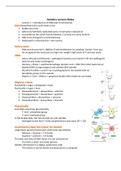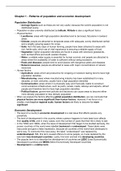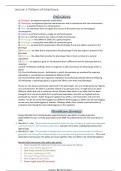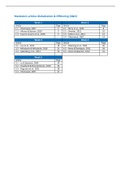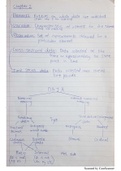INTRODUCTION
Objectives:
• Knowledge on and insight in organization of genetic material and the mechanisms by which genetic
information is maintained throughout generations and is expressed in characteristics and traits
• The way by which genetic changes can take place and are repaired or transmitted is studied in both
prokaryotes and eukaryotes, including higher organisms. Genetic variation and diversity, and the
relationship between genotype and phenotype are discussed, both at the level of the organism and the
population and in an evolutionary context. Epigenetic regulation and quantitative genetics are covered
• Bacteria-eukaryote (model organisms)
• Linking theory and applications
• Classical genetics (inheritance based on phenotype)molecular genetics
Context:
• Relevance of Genetics in the Master of Bioscience Engineering: Cellular and Genetic Engineering
Study material:
• Presentations and recordings (if possible) on Toledo, no compulsory handbook
• Optional: ‘Molecular Genetics of Bacteria’, L. Snyder and W. Champness, ASM Press, 4thedition
Guidance:
• Questions or problems regarding the course material
Exam: 2 parts
• At least8/20 on both parts
Part 1: Genetic variation
1. Structure, organization and replication of genomes
2. Mutation and DNA repair
3. Recombination
4. Chromosomal mutation
5. Transposition and site-specific recombination
6. Plasmids
7. Conjugation, transformation, transduction
Part 2: Development
8. Development and evolution
9. Regulatory RNAs
10. Extranuclear inheritance
11. Epigenetic inheritance
Part 3: Genes at population level
12. Gene mapping (gene and molecular markers), GWAS
13. Quantitative genetics
14. Population genetics
1
Kirsten Van Gils (2023-2024)
,PART 1: GENETIC VARIATION
CHAPTER 1: STRUCTURE, ORGANIZATION AND REPLICATION OF GENOMES
PART A: EUKARYOTIC GENOMES
1. Structure and replication of the chromosome
The structure of DNA
• antiparallel strands
• sugar (deoxyribose : at C2 position -H and no
-OH because that would make DNA unstable)
C3 with -OH is called 3' end
• 5' end has a phosphate group with a negative
charge (DNA is a polyanion molecule )it binds
to kations to obtain a neutral charge
• C-G interactions are stronger than A_T
• the bases are buried inside the DNA helix
• how can a protein find where the bases are?
they have access to them via the major
groove
• extension always occurs via the 3' end
• Karyotype
- The set of chromosomes as seen under the microscope
- Is determined by the number of chromosomes and other visual markers
• Cytogenetics
- Microscopic analysis of the chromosomes and study of the genetic properties (cytology and genetics)
Nuclear genome of female Indian muntjac cells(2n = 6). Six visible chromosomes are
stained with chromosome-specific DNA probes (‘chromosome paint’). Nucleus of
another cell between two divisions. Chromosomes are compacted during cell
division, elongated between cell divisions.
chromosomes are very condensate , no transcription is occurring , condensation
is important for correct segregation. How are they coloured you use a
oligonucleotide with a complementary code (f e repeats in a specific
chromosome) with an attached visual marker
• One DNA molecule per chromosome
- 1960s: Ernest DuPraw Electron micrograph of metaphase chromosomes from a honeybee. Each
chromosome appears as one, long, continuous fiber with diameters of about 30 nm (spaghetti-like
structure).
- only in 1960 it was discovered that there’s only 1 DNA molecule per chromosome
2
Kirsten Van Gils (2023-2024)
,• mitotic chromosome
- 2 chromatids that are attached at the centromere
(metaphase)
- Simplified representation of a metaphase chromosome.
- Metaphase chromosomes are formed after DNA replication.
- Arms are called chromatids (2 chromatids).
1.1. Centromere, telomere, replication
Maintenance of eukaryotic chromosomes: important elements (not genes or regulatory sequences)
1) Centromere
correct segregation of the chromosomes after DNA replication, two copies of each replicated
chromosome are called sister chromosomes, only one single centromere, after replication each
centromere forms a kinetochore
2) Origin of replication
typically found some 30-40 kb apart throughout the length of the eukaryotic chromosome
3) Telomere
resistant to recombination and DNA degradation; replication
centromere
position of the centromere
If you look at metaphase
chromosome you can
locate the chromosomes,
the positions vary. You
can determine the
centromeric index
(important to make
karyograms, to couple
diseases to varying
chromosomes)
• Assembly kinetochore (protein complex) (microtubules) –sister chromatids pairing
• Often visible as a constriction, position of this constriction defines the ratio between the lengths of the two
chromosome arms: short arm p(‘petite’), longer arm q.
• Centromere index: ratio of the length of the short arm to the total length.
• Position of the centromere: telocentric (at one end), acrocentric (close to one end) and metacentric (in the
middle)
How do we stain the centromeres ? these regions have a lot of repeats (so again use radioactive labelled
oligos). In the centromeric regions there aren’t many genes present(mostly repetitive DNA and not
transcript , mostly condensed )
3
Kirsten Van Gils (2023-2024)
,Number of centromere
b) no centromeres:
The segregation happens
randomly (due to diffusion).
You have 4 options , only 2/4
options you have two cells with
each 1 chromosome but if both
are put in the same cell the
cells won’t be viable (so correct
conformation is very important
, chances are 1/2 ^16 if you
have 16 chromosomes , the
case for yeast)
c) two centromeres:
won’t work, the microtubuli
put a lot of force on the
chromosomes , they will break
Centromere structures
b. a lot of repetitive structures
d. the centromeres are very large structures
• Centromere structure of Saccharomyces cerevisiae (yeast)
4
Kirsten Van Gils (2023-2024)
,• Centromere structure of Saccharomyces cerevisiae (yeast)
- Different from human centromeres
- Centromere is 125 bpin length, non-repetitive sequences
- Three elements: CDEI, II and III (‘Cell cycle-dependent element’)
- Sequence CDEII variable (>90 % AT-rich)
o the sequences are almost perfectly conserved, they’re binding sites for proteins
o AT rich regions: they’re known to easily separate the strands
- CDEI andIII: highly conserved across the 16 chromosomes (Mutations reduce centromere function)
- Confer mitotic stability on plasmids
- Specialized protein complex (an alternative to the usual chromatin structure) is formed at CDEII
- CDEII is wound around a core (Cse4(similar structure as H3)and Mif2)
- CDEI and CDEIII are bound by Cbf1 and Cbf3
o the CDE1 and 3 attach to proteins while the rest bind to proteins that look like histones. you
have a dense structure, the proteins that bind the DNA will recruit up to 20 proteins
o Also interact with about 20 kinetochore proteins (attachment site microtubules)
• Centromere structure of animal cells
- in humans it’s not that clear (really huge sequences )you have an
inner shell of H3 histones and another protein outer core .
- Centromeres of chromosomes from animal cellsinclude CENP-
Anucleosomes(replaces H3; more compact and structurally rigid than H3)
and H3-nucleosomes
- CENP-A includes an extended N-terminal tail region which forms a binding
site for another protein component of the kinetochore (CENP-C)
- H3-nucleosomes in the inner core
- Kinetochore is attached to outer side of CENP-A
Origin of replication
5
Kirsten Van Gils (2023-2024)
,• S phase: DNA synthesis phase
• the chromosomes are still attached, after mitosis they’re separated in two different cells
• Site at which the DNA replication machinery assembles for the initiation of replication
• Typically found 30-40 kb apart throughout the length of the chromosome
• DNA unwinding and initiation of replication
Initiation of DNA replication
ORI is a part of the replicator. You have also an initiation protein: only
sequence specific binding protein , the other proteins will interact by
protein-protein interactions or recognise structures of DNA (fe ssDNA or
primer-template junctions ,...)
• Replicator
- set of cis-acting DNA sequences that are sufficient to direct the
initiation of replication
- Origin of replication (ori) is part of the replicator (ori= physical site
of DNA unwinding and initiation of DNA replication)
• Initiator protein:
- recognizes a DNA element in the replicator and activates the
initiation of replication. Regulated by ATP binding and hydrolysis
- Only sequence-specific DNA binding protein involved in the
initiation of replication
- Remaining proteins are recruited through protein-protein
interactions and affinity for specific DNA structures (eg. ssDNA or
primer template junction)
DNA sequences of known replicators share two common
features
complementarity is a strong force so separation is
difficult therefore you need the AT-rich sequence
1) Binding site for the initiator protein
2) Stretch of AT-rich DNA for DNA unwinding
(controlled by the initiator protein)
6
Kirsten Van Gils (2023-2024)
,Identification of replicators
how to identify a replicator:
look at the sequence but that’s no proof ! it can help but it’s
no definite proof.
you need a test :
you introduce a linear part of DNA that cannot replicate on its
own but that has a selectable marker element. Then you
ligate it with chromosomal DNA that is cut in pieces by
restriction enzymes. If in some part of the DNA there is a
replicator these cells that contain the vector with replicator
will be able to grow on specific medium (you select on the
marker). Then you extract the DNA sequence that contains
the origin of replication and study the sequence
Multicellular eukaryotes
• Functioning of replicators is not well-understood
• Larger replicators
• Specific DNA sequences are less important
• Reduced local nucleosome density and nearby transcription are probably important replicator determinants
- transcription can open DNA as well because RNA polymerases also need to be able to access the
bases and you have a primer as well now (during transcription) so these are important elements
Initiator: functions
1) Binding to the replicator DNA via a specific DNA sequence
2) Interaction with additional factors
3) Distortion or unwinding of DNA adjacent to binding site (not
all initiator proteins, eg. Not in yeast)
• Eukaryotes: initiator is a six-protein complex, Origin
Recognition Complex (ORC), best understood in yeast
- Recognizes A and B1
- Hydrolyzes ATP
7
Kirsten Van Gils (2023-2024)
,Eukaryotic chromosomes are replicated exactly once per cell cycle
• they can only be replicated once !!! if that’s not
the case there’s a problem. if there’s a sequence
that’s not replicated yet the chromosomes stay
attached and if they segregate they would break.
• Each bp in each chromosome must be duplicated
once (and only once, otherwise gene duplication
possible)
• Replication during the S phase
• Not all potential origins need to be activated
(typically separated by ~30 kb)
• No origin can be initiated after it has been replicated
• Inactive until the next round of DNA replication
5 ORIs
ORI 3 and 5 initiate
But if ORI3 replicates it will actually pass
over ORI2 as well so ORI2 not activated
because the origin recognition complex
and other proteins are actually removed
by the replication fork (=huge systems
that remove attached proteins). So ORI2 is
passively replicated (same for ori4) so in
the end you have replication of both
strands. So DNA replication can only start
once and then it is inactivated after
initiation.
Initiation of replication in eukaryotes includes two events that occur at distinct times in the cell cycle: (1)
Replicator selection and (2) origin activation (DNA unwinding). Temporal separation ensures that the DNA is
replicated only once during each cell cycle
1) Replicator selection: in G1, assembly of a multiprotein complex at each replicator (pre-replicative
complex)
pre-replicative complex: its inactive the complex, is allowed to assemble in the G1 phase (it binds
the dna but is inactive). In the S phase DNA replication is initiated (so 2 phases: binding + synthesis)
2) Origin activation: in S phase, replicator-associated protein complex initiates DNA unwinding and recruits
polymerase
8
Kirsten Van Gils (2023-2024)
,First step in the initiation of DNA replication in eukaryotes: helicase loading
ORC binds proteins bind and ATP.
They recruit even more proteins.
Helicases are loaded head to head
(so two directions)
Helicase activation and assembly of the replisome
• Pre-RCs are activated to intiate replication by
two protein kinases: Cdk (‘cyclin-dependent
kinase’) and Ddk (‘Dbf4dependent kinase’)
• Both kinases are inactive during G1en are
activated in S phase
• Phosphorylation by the kinases results in the
assembly of additional replication proteins
(including DNA polymerases) at the origin
and the initiation of replication
• MCM complex becomes part of the
replication fork and leaves the replicator
9
Kirsten Van Gils (2023-2024)
, Control of the activity of 100s-1000s of origins of replication: Regulation of helicase loading and activation: one
single round of replication during each cell cycle
• Only one single round of
replication is allowed
• Cdks play two different roles in
regulating replication:
- Required to activate pre
RCs: activation of loaded
helicases to initiate DNA
replication
- Cdk activity inhibits the
formation of new pre-RCs:
inhibition of helicase
loading(inhibit the
function of ORC, Cdc6
andCdt1)
- Activation phase
phosphorylated helicases
cannot be loaded , but
the already loaded
helicases are activated
now.
• Eukaryotes
- Regulation of the initial loading and activation of MCM complex
• Bacteria (see further)
- Regulation of the DnaA initiator protein binding to DNA
- Several initiations per cell cycle possible(E. coli)
10
Kirsten Van Gils (2023-2024)

